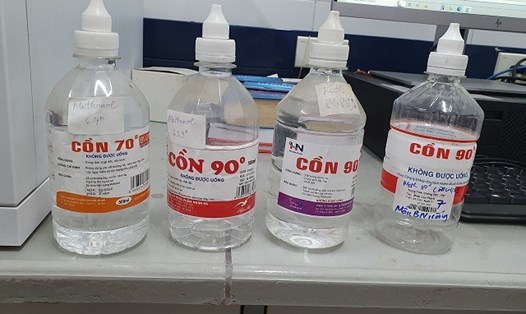Forged insect poisoning
On June 7, the Poison Control Center, Bach Mai Hospital, said that the unit had just received a 55-year-old male patient from Hoang Mai, Hanoi, in critical condition. Patient in a coma, respiratory failure and severe metabolic acidosis. Blood tests showed industrial methanol alcohol concentration of up to 116.63 mg/dL, while brain MRI showed damage to the beuchological neuralgo and cerebral hemorrhage. It is noteworthy that the patient has no history of alcoholism and a healthy body, only having the habit of using alcohol to exfoliate and relieve tooth pain.
According to the patient's family, about a week before admission, the patient has a pulpitis and bought 70 degrees alcohol from a pharmacy near his home to hold and scooped his mouth. The patient is kept continuously for an hour, 3-4 times a day. After three days, the patient began to have symptoms such as headache, dizziness, nausea and vomiting, fatigue, and then a blurred vision. When admitted to the hospital, although the patient is awake and the original survival indicators are normal, the condition quickly deteriorates, with symptoms of coma, respiratory failure and having to place the inner air intubation. Suspecting methanol poisoning, the patient is immediately transferred to the anti -toxic center for treatment and dialysis.

The results of the alcohol sample testing that the patient used showed that although the label stated "70-degree alcohol Ethane", in fact, this product only contained methanol, accounting for 77.5%. Long-term use and application of the mouth lining, especially when there is an open wound caused by tooth decay, has caused methanol to penetrate the patient's body, leading to severe poisoning.
Warning about fake insect repellent
According to Dr. Nguyen Trung Nguyen, Director of the Poison Control Center, Bach Mai Hospital, the situation of methanol poisoning from fake antiseptic alcohol has occurred for many years. Most of these cases lead to blindness, sequelae or even death. Industrial alcohol methanol, despite its poor disinfection capacity, is illegally used and easily penetrates the body through routes such as digestion, skin or respiration. These dangerous bottles are often bottled and labeled with fake labels, deceiving consumers, making them think they are using safe products.
Methanol is often sold in fake form, with labels similar to legitimate antiseptic alcohol products, but in fact contains methanol, which is not in accordance with medical antiseptic standards. These bottles of alcohol are easily available at unprestigious pharmacies and stores. The lack of strict control from authorities has made this situation increasingly serious, leading to serious consequences for public health.
To solve this problem, Dr. Nguyen Trung Nguyen emphasized the important role of authorities in managing and testing toxic chemicals, including methanol, and stopping the dissemination of these products on the market. One of the effective measures is the use of colorants to easily identify methanol in alcohol products, such as in the US, where methanol has been dyed green to warn consumers.
For people, when buying antiseptic alcohol, it is necessary to pay attention to checking the information on the label carefully, ensuring that the alcohol ingredient is clearly Pethanol or isopropanol, not containing methanol. It is also necessary to buy products at reputable pharmacies and require invoices to ensure benefits when problems occur.
Fake insect repellent contains methanol, a serious problem that threatens public health. Strengthening alcohol product management, raising people's awareness and strengthening inspection and supervision from authorities are important steps to prevent this situation.









